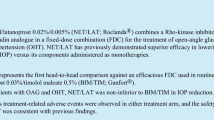Abstract
Pneumatic trabeculoplasty (PNT), when used in combination with antiglaucoma medication, was evaluated in two studies: a feasibility study involving 177 patients, and a separate efficacy study involving 317 eyes. Both studies were nonblinded, single-armed, and nonrandomized; the primary efficacy end point in each study was a decrease in intraocular pressure (IOP) compared with baseline. The first study reported a mean drop in IOP of 6.3 mmHg across the entire group. The second study showed a mean IOP after PNT treatment level at least 1 mmHg less than the pretreatment mean; except at 3, 6, 9, and 12 months, when it was at least 2 mmHg less than the initial mean IOP. The lesser reduction observed in the second study can be explained by the fact that a number of the patients were at least partially controlled by antiglaucoma medications at enrollment, and, as a result, the group had a lower starting IOP than those enrolled in the first study. In both studies, a clear trend to less medication was observed when PNT was added to a patient’s treatment regime. The ability of PNT to reduce IOP and medication requirements, along with its relatively benign safety profile, supports the use of PNT as part of a glaucoma patient’s treatment regimen.
Similar content being viewed by others
References
Sommer A, Tielsch JM, Katz, J., et al. Racial differences in the causespecific prevalence of blindness in east Baltimore [see comments]. N Engl J Med. 1991;325:1440–1442.
Leske MC. The epidemiology of open-angle glaucoma: a review. Am J Epidemiol. 1983;118:166–191.
Society to Prevent Blindness (NSPB). Vision Problems in the U.S. National Society to Prevent Blindness. New York, 1980.
Tielsch JM, Katz J, Singh K, et al. A population-based evaluation of glaucoma screening: the Baltimore Eye Survey. Am J Epidemiol. 1991;134:1102–1110.
Quigley HA. Open-angle glaucoma [see comments]. N Engl J Med. 1993;328:1097–1106.
Schappert SM. National Center for Health Statistics. Office visits for glaucoma: United States, 1991–92. Advance Data from Vital and Health Statistics of the Centers for Disease Control and Prevention; No 262; 1995.
Grant WM, Burke JF, Jr. Why do some people go blind from glaucoma? Ophthalmol. 1982;89:991–998.
Kahn HA, et al. The Framingham Eye Study. I. Outline and major prevalance findings. Am J Epidemiol. 1977;106:17–32.
Kahn HA et al. The Framingham Eye Study. II. Association of ophthalmic pathology with single variables previously measured in the Framingham Heart Study. Am J Epidemiol. 1977;106; 33–41.
Office of Technology Assessment, Congress of the United States. Screening for open-angle glaucoma in the elderly. 1988
Kass MA, et al. Topical timolol administration reduces the incidence of glaucomatous damage in ocular hypertensive individuals. A randomized, double-masked, long-term clinical trial. Arch Ophthalmol. 1989;107:1590–1598.
Epstein DL, et al. A long-term clinical trial of timolol therapy versus no treatment in the management of glaucoma suspects [see comments]. Ophthalmol. 1989;96:1460–1467.
Schulzer M, Drance SM, Douglas GR. A comparison of treated and untreated glaucoma suspects [see comments]. Ophthalmol. 1991;98: 301–307.
Lundberg L, Wettrell K, Linner E. Ocular hypertension. A prospective twenty-year follow-up study. Acta Ophthalmol (Copenh). 1987; 65:705–708.
Hovding G, Aasved H. Prognostic factors in the development of manifest open angle glaucoma. A long-term follow-up study of hypertensive and normotensive eyes. Acta Ophthalmol (Copenh). 1986;64:601–608.
Spooner JJ, Bullano MF, Ikeda LI, et al. Rates of discontinuation and change of glaucoma therapy in a managed care setting. Am J Manag Care. August 2002;S262–270.
Harris J, et al. Determination of the efficacy and mechanism of action for pneumatic trabeculoplasty in the treatment of open-angle glaucoma. Invest Ophthalmol Vis Sci. 1998;39:Abstract 574.
Barraquer JI. Cirugia Refractiva de la Cornea: Historia de la cirugia refractiva de la cornea. Vol. 1. Instituto Barraquer de America, Bogota, Columbia, 1989:pp. 5–64.
Bores LD. Refractive Eye Surgery. Blackwell’s Scientific Publications. Cambridge, England, 1992.
Sachs HG, Lohmann CP, Op de Laak JP. Intraocular pressure in sections with 2 microkeratomes in vitro]. Ophthalmologe. 1997; 94:707–709.
Kim HM, Jung HR. Laser assisted in situ keratomileusis for high myopia. Ophthalmic Surg Lasers. 1996;27(5 Suppl):S508-S511.
Ozdamar A, et al. Bilateral retinal detachment associated with giant retinal tear after laser-assisted in situ keratomileusis. Retina. 1998; 18:176–177.
Rodriguez A, Camacho H. Retinal detachment after refractive surgery for myopia. Retina 1992;12(3 Suppl):S46-S50.
Shepard DD. Intraocular lens implantation—analysis of 500 consecutive cases. Ophthalmic Surg. 1977;8:57–63.
Gürses-Özden R, Liebmann JM, Schuffner D, et al. Retinal nerve fiber layer thickness remains unchanged following laser-assisted in situ keratomileusis. Am J Ophthalmol. 2001;132:512–516.
Author information
Authors and Affiliations
Corresponding author
Additional information
Drs. Leo D. Bores and John T. LiVecchi have stated that they do have significant financial interest or other relationship with a product manufacturer or for Ophthalmic International and (Dr. LiVecchi is Medical Director and a member of the Board of Directors of Coronado Industries). Dr. Guillermo Avalos Urzúa has no financial interest the device. The authors also do discuss the use of off-label products, which includes unlabeled, unapproved, or investigative devices.
Rights and permissions
About this article
Cite this article
Urzúa, G.A., Bores, L.D. & Livecchi, J.T. Pneumatic trabeculoplasty a new method to treat primary open-angle glaucoma and reduce the number of concomitant medications. Ann Ophthalmol 37, 37–46 (2005). https://doi.org/10.1385/AO:37:1:037
Received:
Accepted:
Issue Date:
DOI: https://doi.org/10.1385/AO:37:1:037




